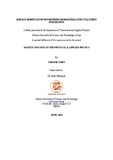| dc.description.abstract | This thesis presented the surface modification of polydimethyl siloxane (PDMS) to enhance surface wettability and surface roughness. Physical and chemical modifications were performed on cured surfaces of PDMS and PDMS-based nanocomposites. Firstly, physical modifications were done by direct coating of PDMS-based substrates with biopolymers such as polyethylene glycol (PEG), poly lactic-co-glycolic acid (PLGA) and sodium alginate (SA).
On the other hand, coatings were done with the biopolymers (PEG, PLGA, and SA) on prestretched PDMS-based substrates. Coated and uncoated, as well as treated surfaces of PDMS and PDMS-based nanocomposites, were characterized by aproscope optical microscope. Substrates wettability were characterized through contact angle measurements. The contact angle measurements were used to determine the hydrophilicity of the coated substrates.
Coated PDMS-based substrates with SA have a contact angle of 12 ̊ showing high hydrophilicity and adhesiveness, followed by PEG with a contact angle of 25, ̊ whilst PLGA recorded a contact angle of 42.2 ̊ for PDMS (10:1). For PDMS (40:1), biopolymer coatings also show a SA contact angle of 18.2 ̊ followed by PEG with a contact angle of 26 ̊ and the PLGA contact angle was 32.2. ̊ There was a significant difference in the contact angle with the
pre-stretched coatings. A pre-stretch contact angle of 8.5 ̊ was recorded for PEG, whilst SA was 36.7 ̊ for PDM (Fe 3 O 4 )10:1. Similarly, the contact angle for a pre-stretched PEG coating was 14.4 and SA was at 22.1 ̊ on PDM (Fe 3 O 4 ) 20:1. SA coating was good for direct physical coating, whilst a PEG coating was good for pre-stretched coating. Also, the chemical modification improved whilst the boiling time decreased the contact angle as a result of
creating a -OH bond. The PDMS-magnetite composites were found to induce heating for hyperthermia treatment. The surface’s wettability and roughness were then discussed to determine the implications of substrates to be used for cell culture. The modified surfaces gave indications of how cells would grow or how substrates would integrate in body tissues. | en_US |

